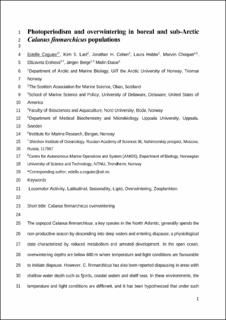| dc.description.abstract | ABSTRACT: The copepod Calanus finmarchicus, a key species in the North Atlantic, generally spends the non-productive season by descending into deep waters and entering diapause, a physiological state characterized by reduced metabolism and arrested development. In the open ocean, overwintering depths are below 600 m, where temperature and light conditions are favourable to initiate diapause. However, C. finmarchicus has also been reported diapausing in areas with shallow water depth such as fjords, coastal waters and shelf seas. In these environments, the temperature and light conditions are different, and it has been hypothesized that under such conditions C. finmarchicus may remain active throughout winter. Here, we investigated changes in the swimming activity of C. finmarchicus from shallow fjords in the eastern North Atlantic during overwintering in response to ambient photoperiod. We conducted monthly experiments with populations from 2 fjords from different latitudes (sub-Arctic Ramfjord, 69°N and boreal Loch Etive, 56°N), measuring the locomotor activity of individual C. finmarchicus stage CVs exposed to a natural light:dark cycle. At both locations, peaks in activity in response to the light cycle were observed to shift from nocturnal during the early overwintering phase to diurnal during mid and late overwintering phase, with a minimal intensity observed during the mid-overwintering phase. In Ramfjord, activity and rhythmicity were generally lower than in Loch Etive. We conclude that C. finmarchicus remains active throughout its overwintering period when in shallow (<200 m) locations but down-regulates its locomotor activity during the main overwintering phase, which we describe as a winter resting state as distinct from classical diapause. | en_US |

